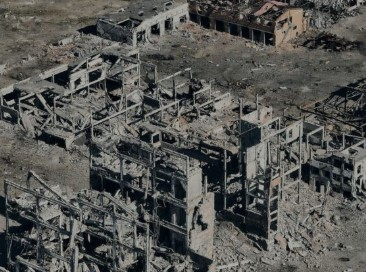The Minsk Agreements: A Failed Path to Peace in Ukraine
Input
Changed
The Origins and Key Provisions of the Minsk Agreements Why the Minsk Agreements Failed Lessons for Future Peace Efforts

The Origins and Key Provisions of the Minsk Agreements
The Minsk Agreements were a series of attempts to bring an end to the ongoing conflict between Ukraine and Russia, which erupted in 2014. These agreements were heralded as a potential path toward peace, yet they ultimately failed to deliver lasting stability to the region. To understand why these peace deals fell short, it is necessary to look at their origins, the key provisions, and the reasons they were unable to resolve the underlying issues that fueled the conflict.
The conflict between Ukraine and Russia began in 2014, following Russia's annexation of Crimea and the subsequent unrest in eastern Ukraine. Pro-Russian separatists, supported by Russian military forces, seized control of parts of the Donetsk and Luhansk regions in Ukraine’s east. The Ukrainian government, backed by Western allies, fought to reclaim these territories, leading to a brutal war that resulted in thousands of deaths and displaced people.
Amid the rising violence, the international community, including the European Union, the United States, and Russia, sought a diplomatic solution. The first of these attempts was the Minsk Agreement, signed in September 2014 in the capital of Belarus. The agreement aimed to bring an immediate ceasefire and begin the process of political and military de-escalation.
The Minsk Agreement, often referred to as Minsk I, was followed by a second round of talks in 2015, which resulted in the Minsk II Agreement. This new agreement was meant to build upon the initial framework, with more detailed provisions intended to address the root causes of the conflict.
The Minsk I and Minsk II agreements outlined several key provisions, including:
A Ceasefire: Both sides were expected to cease all hostilities immediately. The goal was to stop the fighting and prevent further loss of life.
Withdrawal of Heavy Weapons: Both Ukrainian forces and separatist fighters were required to withdraw heavy artillery and other military equipment from the frontlines to create a buffer zone and reduce the likelihood of future conflicts.
Local Elections: The agreements proposed holding local elections in the disputed territories of Donetsk and Luhansk, allowing the people in these regions to determine their political future.
Amnesty and Prisoner Exchanges: A provision for amnesty was included to encourage the release of prisoners on both sides, and there were plans for an exchange of detainees.
Decentralization of Power: A key provision was the granting of special status to the Donbas region, allowing greater autonomy for the separatist territories, particularly with regard to language rights, local governance, and policing.
Despite these ambitious goals, the agreements quickly became mired in challenges, and the peace they promised was elusive.

Why the Minsk Agreements Failed
There were several reasons the Minsk Agreements failed to bring about lasting peace in Ukraine. These reasons highlight the complex political, military, and geopolitical dynamics at play and underscore the difficulty of resolving such a deep-seated conflict.
Lack of Trust Between the Parties
One of the fundamental problems with the Minsk Agreements was the deep lack of trust between the Ukrainian government and the pro-Russian separatists, supported by Moscow. Ukraine viewed the separatists as Russian puppets, while Russia denied its active military involvement in the conflict. For Ukraine, negotiating with what it saw as Russian-backed militants was a non-starter, and similarly, the separatists were not willing to make significant compromises without assurances from Russia. This deep distrust made it nearly impossible to reach meaningful compromises on the ground.
Russian Non-Compliance
Another significant factor was Russia’s lack of compliance with the agreements. While Russia had signed the agreements, it was clear that Moscow had little incentive to fully implement them. The provision calling for the withdrawal of Russian troops and military support from the separatist regions was never carried out. Russia continued to supply weapons, training, and even direct military support to the separatists, undermining the ceasefire and the other provisions of the agreements.
Unrealistic Political Demands
The political demands outlined in the agreements, particularly regarding the decentralization of power to the Donbas region, were highly contentious. The Ukrainian government was unwilling to grant the level of autonomy demanded by the separatists, fearing that it would effectively amount to granting them veto power over the country’s future. Furthermore, the proposal to hold local elections in the separatist-controlled territories was also contentious, as Ukraine argued that elections could not be free and fair under conditions of occupation and violence. The disagreement over these political elements was one of the primary obstacles to achieving a lasting peace.
Continued Fighting on the Ground
Despite the ceasefire provisions of the Minsk Agreements, fighting continued sporadically along the frontlines in eastern Ukraine. The lack of effective monitoring and enforcement mechanisms allowed both sides to violate the ceasefire with impunity, leading to regular skirmishes, shelling, and casualties. The failure to establish a robust mechanism for peacekeeping and monitoring contributed significantly to the lack of progress toward peace.
Geopolitical Factors
The geopolitical dynamics of the conflict also played a role in the failure of the Minsk Agreements. The West, led by the U.S. and European Union, placed heavy sanctions on Russia in response to its actions in Ukraine, including the annexation of Crimea. These sanctions were a key point of contention in the negotiations, as Russia demanded their removal in exchange for implementing the agreements. Conversely, Western powers, including Ukraine’s allies, were unwilling to ease sanctions without concrete steps from Russia to withdraw its forces from Ukraine.
The ongoing political and military support of Russia for the separatists further complicated efforts to bring both sides to the negotiating table. As a result, the Minsk Agreements became a tool for prolonging negotiations without any tangible results, rather than an actual blueprint for peace.

Lessons for Future Peace Efforts
The failure of the Minsk Agreements serves as a cautionary tale for future peace efforts in Ukraine and other conflict zones. Several key lessons can be drawn from the experience:
The Importance of Trust-Building: Any peace agreement must prioritize building trust between all parties involved. The lack of trust between Ukraine and the separatists, as well as between Ukraine and Russia, was a major obstacle to progress.
International Support and Enforcement: For a peace agreement to be successful, it is crucial that the international community not only broker the deal but also actively support its implementation and monitor compliance. This includes ensuring that all parties adhere to their commitments and enforcing consequences for violations.
Realistic Political Solutions: The political demands of any peace agreement must be grounded in the realities of the conflict. Unrealistic demands, particularly those related to autonomy and governance, can undermine the potential for a lasting peace.
Geopolitical Considerations: The broader geopolitical context, including the interests of regional and global powers, must be considered when crafting peace agreements. The influence of Russia in the conflict and its role in undermining the Minsk process highlights the importance of addressing such dynamics in future peace efforts.
The Minsk Agreements were a bold attempt to bring an end to the war in Ukraine, but their failure to deliver peace is a testament to the complexities of the conflict. The lack of compliance, political disagreements, and deep-seated mistrust among the parties ultimately doomed the process. As the war continues to evolve, the lessons learned from Minsk will be crucial in shaping any future peace efforts. Until a genuine and sustainable resolution is found, the path to peace in Ukraine remains uncertain.





















